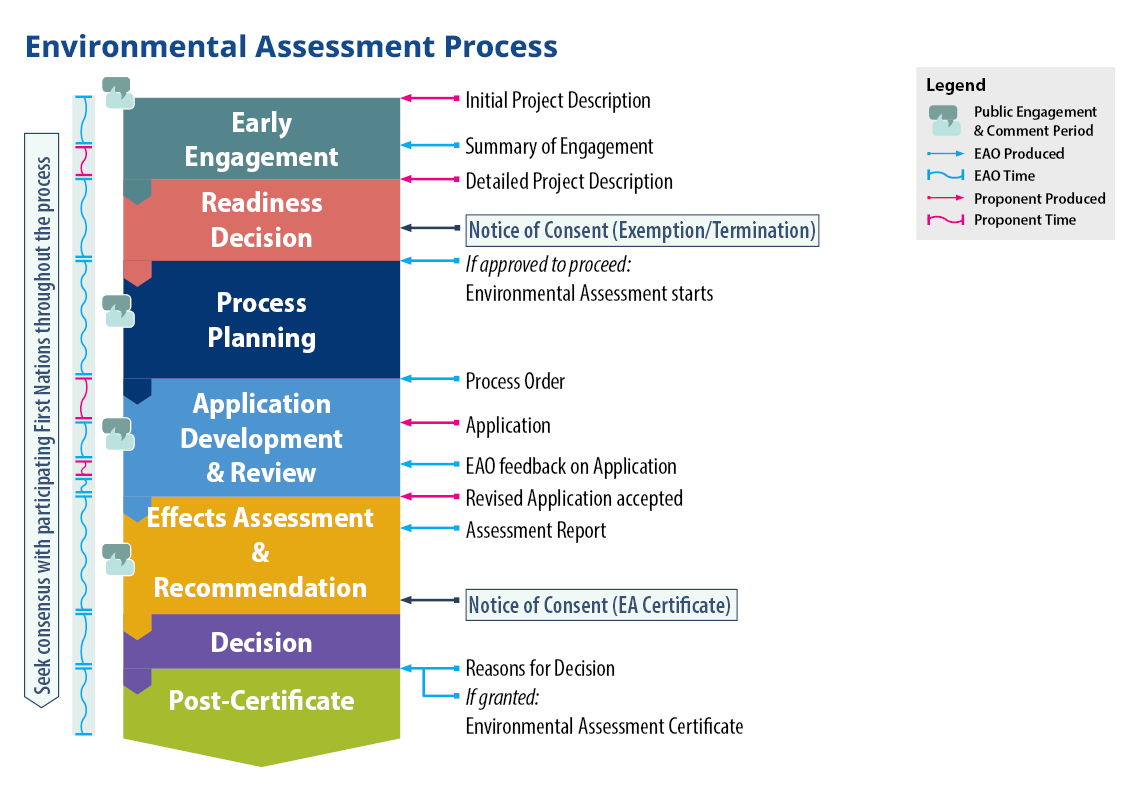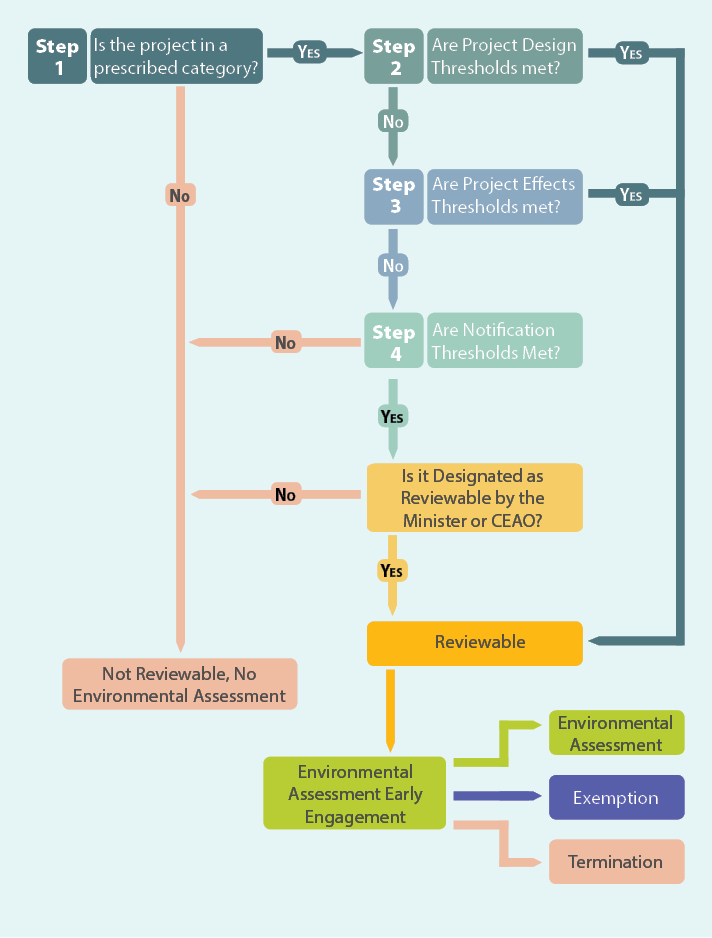Environmental assessment process
Major projects in B.C. are assessed for potential environmental, social, economic, health and cultural effects by the Environmental Assessment Office.
On this page
- Reviewable projects
- Early engagement
- EA readiness decision
- Process planning
- Application development and review
- Effects assessment and recommendation
- Decision
- Post certificate and compliance & enforcement
There are 7 phases in the environmental assessment process which are outlined in the following graphic and summarized below.
A detailed overview of the environmental assessment process is available in the Environmental Assessment User Guide (PDF, 1.6 MB). Detailed resources for each phase of the EA process are available on the guidance documents page.
Information specific to Indigenous nation or public participation in the EA process is also available.

Reviewable projects
A reviewable project in British Columbia is an activity and/or facility described in the Reviewable Projects Regulation (RPR). The RPR identifies activities and/or facilities that may have significant adverse effects and sets criteria for when a project needs to undergo an environmental assessment. Reviewable projects need an environmental assessment certificate or an exemption order before they can be constructed. A proposed project may become reviewable in three ways:
- The project meets the criteria of the Reviewable Projects Regulation
- The Minister of the Environment and Climate Change Strategy, after considering the required factors, designates an eligible project as reviewable. This can happen following either:
- An application to the Minister (for example, made by an Indigenous nation or member of the public)
- Through a referral from the chief executive assessment officer after a review of a project notification, or
- By the Minister’s own initiative
- When a proponent of a project that is not automatically reviewable requests designation, and the chief executive assessment officer grants this request.
The figure below shows a four-step process to help determine if a project is reviewable.

Early engagement
The Early Engagement phase is the start of the regulatory process with the Environmental Assessment Office and provides an opportunity for all participants to better understand the project and establish a foundation for the rest of the environmental assessment. Early engagement is an important preparatory phase where meaningful conversations among participants begin about the proposed project to identify engagement approaches, potential interests, issues, and concerns early in the environmental assessment process and chart a path for resolution. First Nations interested in participating in the environmental assessment process as participating Indigenous nations must provide notice during early engagement. The EAO begins working with participating Indigenous nations to customize consensus seeking approaches with each nation for the rest of the environmental assessment process.
Environmental assessment readiness decision
Using the foundation provided by the early engagement phase, a decision is made on whether a project should proceed to an environmental assessment during the readiness decision. Typically, the early engagement phase will provide enough information to confirm readiness to start an environmental assessment, with key issues identified for resolution later in the environmental assessment process. Occasionally, a project may be terminated or exempted from an environmental assessment, by a Minister’s decision. Participating Indigenous nations have an opportunity to provide a notice of their consent or lack of consent if the recommendation is to exempt or terminate the project from the environmental assessment process.
Process planning
Process planning formalizes how the environmental assessment must be carried out, including:
- identifying the required information
- defining who does what, when, and how
- determining how participants work together for the rest of the environmental assessment and future engagement approaches (including public engagement)
Each Process Order is customized to reflect the project and uses the foundation built in the early engagement and the readiness decision phases to set the scope, procedures, and methods of the environmental assessment.
Application development and review
During application development, the proponent works with participating Indigenous nations and environmental assessment participants to develop their application for an environmental assessment certificate. Early feedback on data collection or analysis can help to identify and resolve key issues, reducing the potential for delays later in the process.
During Application Review, the EAO, participating Indigenous nations, Technical Advisory Committee, and Community Advisory Committee review the application and direction is provided to the proponent on revisions that should be reflected in the revised application. The direction includes the results from public engagement in the draft application and any matters regarding advice provided by the Technical Advisory Committee or Community Advisory Committee.
Effects assessment and recommendation
An effects assessment of the project is conducted, resulting in development of a draft Assessment Report and draft environmental assessment certificate (with conditions). These drafts reflect engagement with participating Indigenous nations, the Technical Advisory Committee, and the Community Advisory Committee. Before referral to provincial decision-makers, the public will have an opportunity to comment on the draft Assessment Report that describes the potential effects of the project, and the draft EA Certificate and associated legally binding conditions the proponent must follow for the life of the project, should a certificate be issued.
Recommendations to inform Provincial decision-makers are also prepared. Participating Indigenous nations have the opportunity to provide notice of their consent or lack of consent to issuing an environmental assessment certificate.
Decision
Once the referral package is submitted to provincial decision-makers, the Ministers must consider the Assessment Report, the chief executive assessment officer’s recommendations, the sustainability and reconciliation purposes of the EAO and any other matters they consider relevant to the public interest. If the recommendation on whether the project is consistent with the promotion of sustainability does not align with a notice of consent or lack of consent, Ministers must offer a meeting to that participating Indigenous nation.
Ministers can decide to issue a certificate or refuse to issue a certificate, and are required to publish reasons for their decision. If the Ministers’ decision does not align with the notice of consent or lack of consent provided by participating Indigenous nations, reasons must be provided.
Post certificate and compliance & enforcement
If an environmental assessment certificate is issued, post-certificate activities include mitigation effectiveness reports and may include audits, certificate amendments, extensions, and transfers.
The compliance & enforcement branch of the EAO conducts compliance inspections of regulated parties and projects, and, where required, uses enforcement to ensure that projects are designed, built, operated, and decommissioned or reclaimed in compliance with the legally binding requirements of the Act, its regulations and any environmental assessment certificates or exemption Order.
